Mohammad Jamil
Chairman CPEC Authority, Lt. General (R) Asim Saleem Bajwa, has informed that the Central Development Working Party (CDWP) has approved the railway Main line (ML-1) project, worth of US$7.2 billion, and recommended it to the Executive Committee of National Economic Council (ECNEC). It is a big milestone for the second phase of CPEC, he added. He further said the ML-1 scope included dualization and up-gradation of 1872 km railway track from Peshawar to Karachi, up-gradation of Walton Academy. Moreover, a Dry Port at Havelian would also be built under ML-1 of CPEC. In his tweet, Asim Bajwa, who is also Special Advisor to the Prime Minister on Information and Broadcasting, said the project scope included dualization and up-gradation of 1872 km Railway track from Peshawar to Karachi. Under the project, Walton Academy would also be up-graded besides building a dry port at Havelian.
CPEC is making progress amid the outbreak of COVID-19. The cargo ship “SIBULK TRADOTION” carrying Afghan transit trade goods has reached Gwadar Port following strict Standard Operating Procedures (SOPs) on COVID-19. CPEC is an exemplary and great plan of regional connectivity and economic development of the whole region. The development of Balochistan under CPEC is the government’s key priority. Chairman CPEC Authority Lt. Gen (R) Asim Saleem Bajwa held a meeting with Chief Minister Balochistan Jam Kamal and discussed all CPEC projects. The key areas of discussion included water reservoirs, large-scale agriculture farms, development of Gwadar Port and Special Economic Zones (SEZs) in Hub and Bostan. Chief Minister Jam Kamal asserted that new investment and infrastructure development in Balochistan is key to real success and prosperity. He further appreciated Chairman Asim Bajwa’s commitment and efforts for the development of Balochistan under CPEC.
Commercial Counselor, Pakistan Embassy in China, Badar-uz- Zaman while participating online in the “China-Pakistan Economic and Trade Hotline Cloud Salon-Joint Locust Control” event organized by New-China Economic Net stated: “The trade volume between Pakistan and China has grown rapidly showing an increase from US$4 billion in the year 2004-2005 to around US$20 billion in the recent years. He said that the second phase of the China-Pakistan Free Trade Agreement has been implemented since 1 January 2020, and bilateral trade has grown. Pakistan has exported 313 items to China tax-free, and it is likely to export nearly 5,000 tax-free items in the next 10 years, which is a great concession by China – unparalleled in the history of trade with the US and the West. China is a sincere friend of Pakistan who stood by the latter when Pakistan economy was in dire straits.
But the US and the West continue with their criticism of CPEC and other China’s initiatives; however, China’s rise appears to be unstoppable. Barring the US and the West, there is consensus among analysts and economists that China is an unstoppable economic juggernaut rising across the Pacific, and poised to displace the US. The Trump Administration’s efforts to limit Chinese access to US technology and research universities can be understood as consequence of Americans fear. Some of them believe that China’s relative economic power will soon hit its zenith before entering a sustained period of decline. An author in BARRONS, wrote: “Consider Khrushchev. “Whether you like it or not,” he famously told a delegation of western diplomats in November 1956, “history is on our side. We will bury you!” He was expressing his confidence in the superiority of the Soviet system and the eventual collapse of the capitalist West. But the Soviet Union was buried in the process.
But China’s case is different, as it has embraced market economy, but it is being monitored by the Communist Party. In dollar terms, Chinese output was worth just 10% of US production in the mid-1990s. By 2019, the Chinese economy had grown to 66% of America’s size. During 2001 to 2011, China’s gross domestic product (in dollars) per working-age adult rose about 18% each year, compared with about 3% each year in the US. The massive gap in growth rates lifted Chinese output from 13.5% to 48% of US GDP. In 2007, according to the then Premier, Wen Jiabao, that boom was unstable, unbalanced, uncoordinated and unsustainable. The problem was that the surge in growth was driven by excessive investment and soaring indebtedness even as ordinary Chinese had their incomes squeezed relative to the value of what they produced – the same phenomenon that had temporarily inflated the Soviet economy.
But China is out of the woods and continues to work for the development of developing countries. In addition to supplies related to locust control, Commercial Councilor Badar believes that high-tech agricultural machinery is also needed to develop Pakistan’s agriculture. “Our tractors are well manufactured and we will also make some exports, but on the technical level, we lack the most advanced machinery. China’s high-tech machinery can be exported to Pakistan.” Badar also said that the state is also funding to encourage farmers to actively use agricultural machinery to increase production. In the online event, companies such as Zhongnong Lihua, DJI, Luba and other pesticides, sprayers and unmanned aerial vehicles were invited to do online demonstrations. The second phase of the multi-billion-dollar economic cooperation between Pakistan and China will have a special emphasis on agriculture, industry, trade and science and technology, Chairman CPEC Asim Saleem Bajwa said in an interaction with local media.










